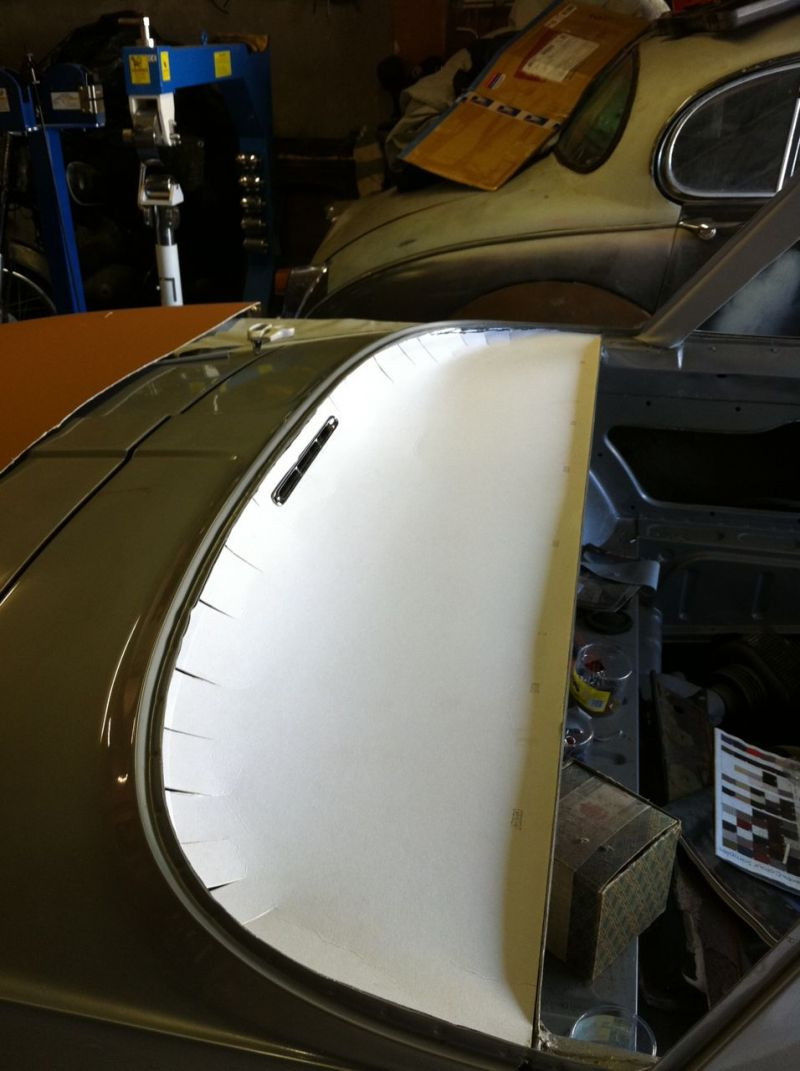Rear Parcel Shelf Installation
As with assembling most things, whether an Ikea flat pack, or a classic car, the order in which things are put together is pretty important. This is especially true of the Type 34 interior.
The interior trim is installed in such a way that each part must be fitted in the correct order. The headlining is the first part in this jigsaw puzzle, it fits underneath the front and rear screen rubbers and also the side trim around the door aperture and so needs to be installed first. Next is the rear parcel shelf. This also fits underneath the rear screen rubber, much the same way that the headlining does.
My rear parcel shelf was too badly warped to be reused, but I had carefully stored it for use as a pattern. Unfortunately I could not find it, and so had to make one from scratch. My guess is that somewhere between the UK and here, and several moves in between, it simply got lost. Not too worried, I set about locating some suitable card.
Finding a bit of card large enough was not an easy task, the overall dimension is larger than most art suppliers stock (it’s bigger than A0), fortunately I managed to find a stockist that had some oversize stuff in stock. The card I used was 2mm thick, which is thick enough to retain it’s shape but thin enough to bend up to the rear screen.

Cutting out the shape was simple enough, I simply laid the car over the rear parcel shelf and cut it out oversize, allowing me to trim it down to size afterwards. With the shape determined, I cut some ‘darts’ around the bends to allow the card to bend into shape. The idea here is to get the card to sit so that it wedges into position between the front lip of the shelf and the rear edge. After a small amount of trimming It looked pretty good. At this stage it’s important to go and find the vent trim cut out the aperture for and make sure that it fits by screwing it in position. once you are happy it’s time to cover it.

I decided to use the same material as the headlining to cover the shelf. This is not technically correct as originally it would have been covered in the same vinyl material as the door cards, which incidentally would also be a lot more forgiving to fit as it is a little heavier than the headlining material. But being a custom, that’s what I wanted.
I started by clipping the material in position in much the same way I did for the headliner – as I blogged about in this post. Using the same technique I started in the middle and worked my way outwards until the creases had been removed. Once happy with the fit I un-clipped one side at a time and applied the contact adhesive. I used the same glue that I did for the headliner, a special automotive contact adhesive that is heat resistant and will not come unstuck on hot days.

The trick is to apply the glue to the face of the card and approximately 3/4 of the way up the card. The last part of the material is not glued and naturally forms the remainder of the curve. The material is then glued to the window seam in the same manner as the headliner was. At this stage the front edge of the shelf is not glued, it is simply left clipped in position.
Once you have done both sides, it’s time to turn your attention to the inside. The material should be glued tightly to the inside of the front edge of the shelf, to the face of the shelf and then underneath the shelf. One thing to note here is that on the top in the centre there is a hook mounted to hook the seat retaining strap to. I checked before fitting the shelf that I could access the holes from underneath. This made it easy to poke the holes through from underneath to locate the position that the hook mounted in.
The hardest part of the whole job was removing the creases from the material around the part where the glass curves forwards, the material has a tendency to ‘gather’ here and the excess material is hard to stretch out. I managed to get almost all of the creases out but was still left with one or two. I’m sure that there is a technique to help get rid of these – perhaps using a heat gun, or entrusting it to the professionals, but despite the creases, which are mostly hidden beneath the window rubber, I’m pretty happy with the results.

